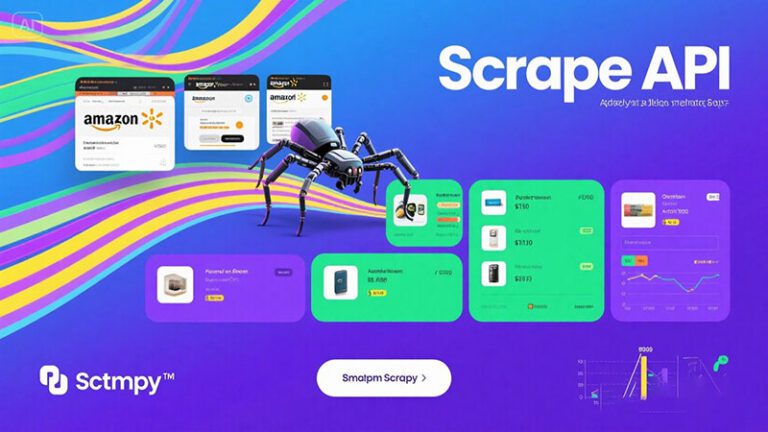In today’s data-driven e-commerce era, obtaining accurate and real-time Amazon product data is crucial for market analysis, competitor monitoring, pricing strategies, and operational optimization. However, scraping data directly from Amazon comes with numerous challenges, including complex page structures, dynamic content loading, and powerful anti-scraping mechanisms. This article provides a detailed guide on how to efficiently and reliably scrape Amazon product detail data using the powerful tool—Pangolin Scrape API. We’ll cover step-by-step instructions, code examples, and best practices to help you overcome data collection challenges with ease.
Challenges of Scraping Amazon Data
Manual copy-paste or traditional web scraper scripts often fall short when dealing with a massive e-commerce platform like Amazon. Here are some common pain points and challenges:
- Robust Anti-Scraping Mechanisms: Amazon has invested heavily in anti-bot technologies, including IP bans, CAPTCHA, User-Agent detection, behavioral analysis, etc., making it easy for conventional scrapers to get blocked.
- Dynamic Content Loading: Many product details such as prices, reviews, and inventory are dynamically loaded via JavaScript, making them inaccessible to traditional scrapers.
- Frequent Page Structure Changes: Amazon regularly updates its page structure, requiring frequent maintenance and updates to scraper scripts, increasing time and development costs.
- Scalability and Speed: Building and maintaining your own scraping infrastructure for large-scale, high-frequency data collection can be expensive and difficult to scale reliably.
- Regional Data Variations: Amazon marketplaces vary by country, with differences in product info, pricing, and promotions. Collecting region-specific data requires handling proxies and geolocation simulation.
- Legal and Compliance Risks: Improper data scraping may violate laws and regulations, leading to legal or compliance issues.
Facing these challenges, more businesses and developers are turning to professional, high-efficiency data scraping API services. Pangolin Scrape API was built exactly for this purpose—to address these pain points and provide a stable and reliable solution for Amazon data scraping.
Pangolin Scrape API: A Powerful Tool for Amazon Data Collection
Pangolin Scrape API is a cloud service specifically designed for web scraping. It enables users to quickly, easily, and reliably obtain data from Amazon and other websites. With simple HTTP requests, it returns structured JSON data in a user-friendly way, greatly simplifying the data extraction process.
Key Advantages of Pangolin Scrape API
- Easy to Use: No need to write complex scraping code. Just send an HTTP request using Python’s
requestslibrary. Pangolin provides comprehensive documentation and code samples. - Fast and Efficient: Powered by distributed cloud architecture, it can handle multiple requests concurrently, ensuring timely and accurate data delivery—often within seconds.
- Reliable and Stable: Equipped with advanced anti-blocking techniques that mimic real user behavior, it effectively bypasses Amazon’s anti-bot systems.
- Highly Customizable: Supports various parameters, allowing you to customize fields, target marketplaces, zip codes, and more for precise data retrieval.
- Structured JSON Output: The API returns data in structured JSON format, making it easy to integrate into analytics pipelines and applications.
- Cost Effective: Avoid the high costs of building and maintaining your own scraping infrastructure. Pangolin offers a high-ROI data acquisition solution.
How Does Pangolin Scrape API Work?
The workflow of Pangolin Scrape API typically involves:
- Request Initiation: Users send a request with parameters such as the target Amazon product URL or ASIN, marketplace, and desired fields.
- Intelligent Handling: The API selects appropriate IPs and routing using its proxy pool and smart algorithms, simulating real user visits.
- Scraping and Parsing: It handles dynamic loading and JavaScript rendering automatically, extracting data like titles, prices, ratings, images, descriptions, reviews, etc.
- Structured Response: The scraped data is returned in structured JSON format.
Step-by-Step Guide: Scraping Amazon Product Details Using Pangolin Scrape API
Step 1: Register an Account and Get Your API Key
First, register an account at Pangolin’s official website. After logging in, find your API token in the dashboard—this will be used to authenticate API requests.
Step 2: Set Up Your Python Environment
Ensure Python is installed on your system. If not, download it from the official Python website. Also, install the requests library:
pip install requests
Step 3: Write Python Code to Scrape Product Data
import requests
import json
API_KEY = "YOUR_PANGOLIN_API_KEY"
API_ENDPOINT = "https://api.pangolinfo.com/v1/amazon/product"
HEADERS = {
"Authorization": f"Bearer {API_KEY}"
}
PRODUCT_ASIN = "B08N5WRWNW"
MARKETPLACE = "US"
FIELDS_TO_SCRAPE = "title,price,rating,images,description,feature_bullets,reviews_total"
params = {
"asin": PRODUCT_ASIN,
"marketplace": MARKETPLACE,
"fields": FIELDS_TO_SCRAPE
}
def scrape_amazon_product_details(api_endpoint, headers, params):
try:
response = requests.get(api_endpoint, headers=headers, params=params, timeout=60)
response.raise_for_status()
product_data = response.json()
print(f"Title: {product_data.get('title')}")
print(f"Price: {product_data.get('price', {}).get('current_price')} {product_data.get('price', {}).get('currency')}")
print(f"Rating: {product_data.get('rating')}")
print(f"Total Reviews: {product_data.get('reviews_total')}")
return product_data
except requests.exceptions.RequestException as e:
print(f"API request failed: {e}")
return None
except json.JSONDecodeError as e:
print(f"JSON decode failed: {e}")
print(f"Response content: {response.text}")
return None
if __name__ == "__main__":
print(f"Scraping ASIN: {PRODUCT_ASIN} from marketplace: {MARKETPLACE}")
product_info = scrape_amazon_product_details(API_ENDPOINT, HEADERS, params)
if product_info:
pass # Add data saving or further processing here
Step 4: Parsing and Saving the Data
The returned JSON can be used directly in Python. Based on your needs, you can save the data to:
- JSON Files: Save each product’s data as a JSON file.
- CSV Files: Extract key fields and store them as rows in a CSV file for analysis.
- Databases: For large-scale or long-term use, save the data in a database (e.g., PostgreSQL, MySQL, MongoDB).
Example: Save Data to CSV
import csv
def save_to_csv(product_data, filename="amazon_products.csv"):
if not product_data:
return
fieldnames = ['asin', 'title', 'price', 'currency', 'rating', 'reviews_total', 'url']
row_data = {
'asin': product_data.get('asin'),
'title': product_data.get('title'),
'price': product_data.get('price', {}).get('current_price'),
'currency': product_data.get('price', {}).get('currency'),
'rating': product_data.get('rating'),
'reviews_total': product_data.get('reviews_total'),
'url': product_data.get('url')
}
try:
with open(filename, 'r', newline='', encoding='utf-8') as f:
pass
write_header = False
except FileNotFoundError:
write_header = True
with open(filename, 'a', newline='', encoding='utf-8') as csvfile:
writer = csv.DictWriter(csvfile, fieldnames=fieldnames)
if write_header:
writer.writeheader()
writer.writerow(row_data)
print(f"Data appended to {filename}")
Advanced Tips & Best Practices
- Batch Requests and Concurrency: Use loops or async libraries (like
asyncio,aiohttp) for bulk scraping, while respecting API rate limits. - Selective Fields: Specify only the fields you need to minimize response size and cost.
- Robust Error Handling: Implement retry logic for recoverable errors (e.g., timeouts).
- Secure API Key Management: Store your API keys securely, avoid hardcoding in shared code.
- Compliance Awareness: Follow Pangolin’s terms and local data usage laws.
- Data Validation: Clean and validate data before storage and analysis.
- Monitor API Usage: Track your quota and usage to avoid service interruption.
- Leverage Parameters: Use advanced parameters like
zip_codeandrender_jsfor more precise control. - Set Refresh Strategies: Schedule regular re-scraping for volatile data like price or stock.
Comparison: Pangolin Scrape API vs. Traditional Methods
| Feature | Pangolin Scrape API | Traditional Scrapers | Manual/Extensions |
|---|---|---|---|
| Dev Cost | Low | High | Very low |
| Maintenance | Minimal | High | None |
| Anti-bot Handling | Excellent | Varies | Weak |
| Stability | High | Medium | Low |
| Efficiency | High | Depends | Very low |
| Data Format | Structured JSON | Custom parsing | Unstructured |
| Region Support | Built-in | Manual setup | Limited |
| Compliance | Handled by provider | On your own | Low risk (small scale) |
Conclusion: Empower Your Amazon Insights with Pangolin Scrape API
Amazon’s complex data environment demands a robust solution. Pangolin Scrape API offers a powerful, efficient, and user-friendly option for extracting accurate and timely product data. Whether for market research, price tracking, competitor analysis, or campaign optimization—high-quality data is key to success.
By choosing Pangolin Scrape API, you can:
- Focus on data use, not scraper maintenance
- Obtain high-quality, structured data
- Improve scraping efficiency and reliability
- Reduce costs and risk
Start using Pangolin Scrape API today and unlock the full potential of Amazon data to supercharge your e-commerce strategies!
Disclaimer: This article is for educational purposes only. Please ensure that your use of APIs complies with all applicable laws and platform terms.
References:
- Pangolin Scrape API User Guide
- Amazon Scraping API – Real-time Amazon Data at Your Fingertips – Pangolin
- How to Use Pangolin Scrape API to Scrape Amazon Product Data – Pangolin
是否需要我帮你生成适配 WordPress 的 HTML 段落格式版本?


